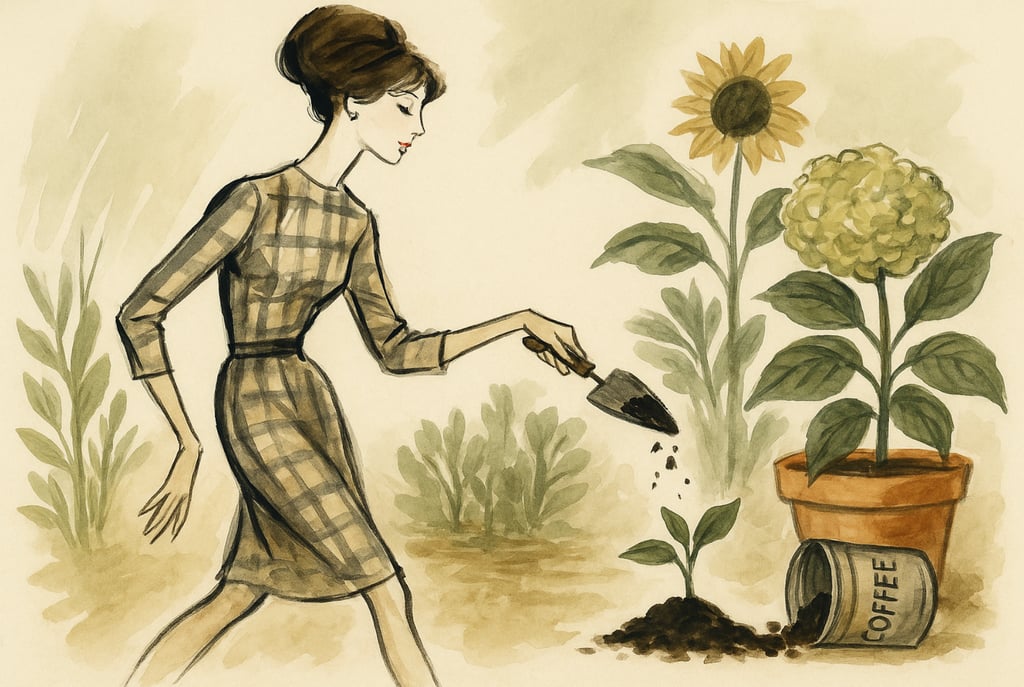Perk Up Your Plants: Which Garden Friends Love Coffee Grounds?
Give your morning coffee a second life — learn how to reuse coffee grounds to nourish plants, improve soil, and keep your garden naturally thriving.
RE USE


At Hoia Dream Home, we believe the best gardens aren’t just beautiful — they’re full of life, ritual, and resourcefulness. So if you’ve been tossing your used coffee grounds in the bin each morning, it might be time to rethink your routine. That morning cup of joy? It could be just what your plants are craving.
Coffee grounds aren’t just compostable — they’re rich in nitrogen, improve soil texture, and offer a subtle acidity that some plants truly thrive on. Here's your guide to the flowers, fruits, and vegetables that love a bit of caffeine in their diet.
Why Coffee Grounds?
Coffee grounds contain:
Nitrogen (great for leafy growth)
Small amounts of phosphorus and potassium
Organic matter that improves drainage and aeration
A touch of acidity, which some plants adore
Just be careful: fresh grounds can be too acidic or dense — stick to used coffee grounds, and mix into compost or topsoil in moderation.
Plants That Love Coffee Grounds
1. Roses
They’re not just romantic — they’re hungry. Coffee grounds sprinkled around the base of rose bushes can encourage lush foliage and deep blooms. Just mix them lightly into the soil to avoid mould.
2. Hydrangeas
Want to shift your pink hydrangeas to blue? Coffee grounds can gently acidify your soil, encouraging bluer flowers. Nature’s alchemy in a teacup.
3. Azaleas & Rhododendrons
These forest-floor lovers thrive in acidic, well-drained soil. Add a handful of coffee grounds to their soil mix once a month — it mimics their natural woodland environment.
4. Blueberries
If you’re lucky enough to grow these in your Hoia garden, you know they prefer acidic, fertile soil. Coffee grounds are like a slow-release vitamin for them — mix into compost or scatter thinly around the root zone.
5. Carrots & Radishes
Root vegetables benefit from the loosened soil texture and gentle nitrogen boost. Blend coffee grounds into your seed rows before planting — it encourages strong root development.
6. Tomatoes (with caution!)
Tomatoes can enjoy a light sprinkle, but too much acidity can stress them. Try adding coffee grounds to your compost first — not directly to tomato roots — and apply sparingly.
Bonus: Grounds vs. Pests
Slugs and snails don’t love crawling over gritty, caffeinated soil. Sprinkling a ring of coffee grounds around young plants may act as a gentle pest deterrent, especially in spring when shoots are vulnerable.
How to Use Coffee Grounds in Your Garden
In Compost: Balance with brown materials (dry leaves, cardboard) to avoid over-acidifying.
As Mulch: Mix with straw or bark — don’t use coffee alone, as it can compact.
In Soil: Dig in lightly — especially near acid-loving plants.
In Watering Cans: Steep grounds in water for a few hours to make a mild garden “tea.”
A Garden That Feels Like Home
At Hoia Dream Home, we love small, natural rituals — scattering dried petals, soaking beans in spring water, and now… composting your morning coffee. It’s not about perfection. It’s about rhythm, connection, and nourishing the soil that nourishes you.
So tomorrow morning, as you tip the last sip of coffee down the sink — pause. Maybe your roses want a taste too.
